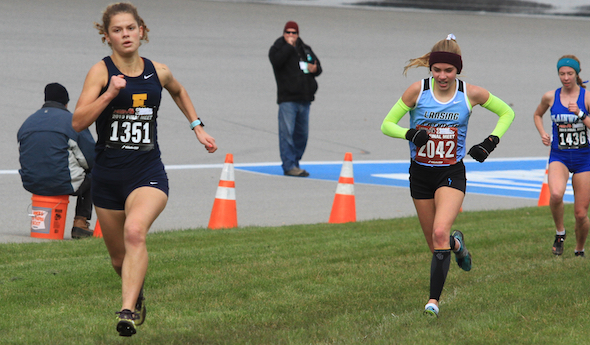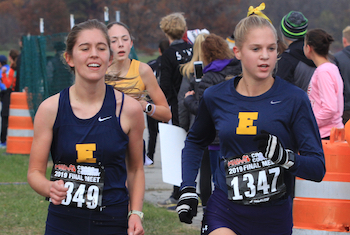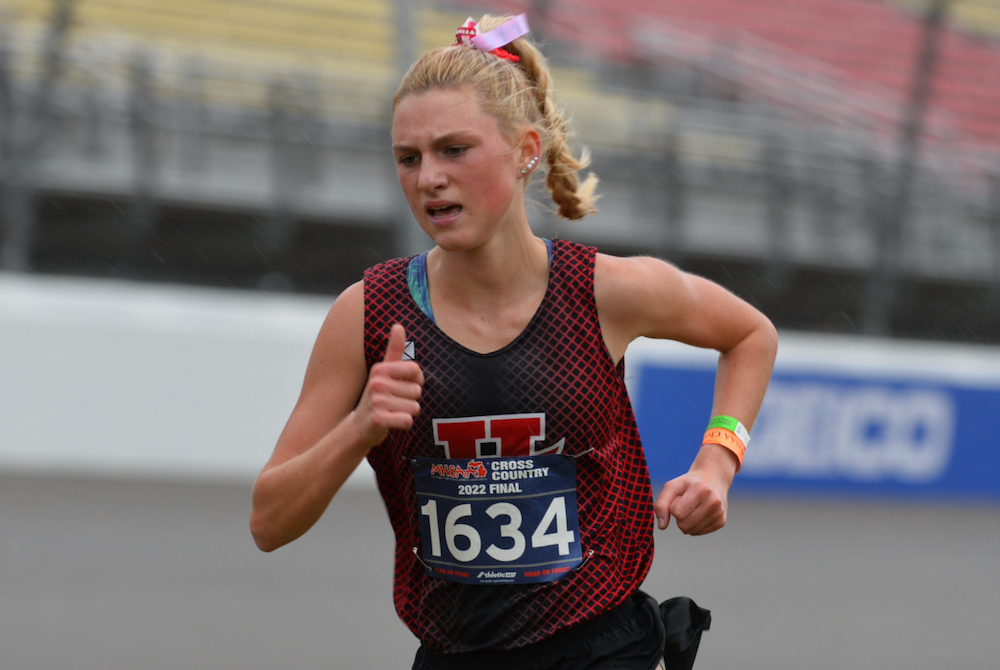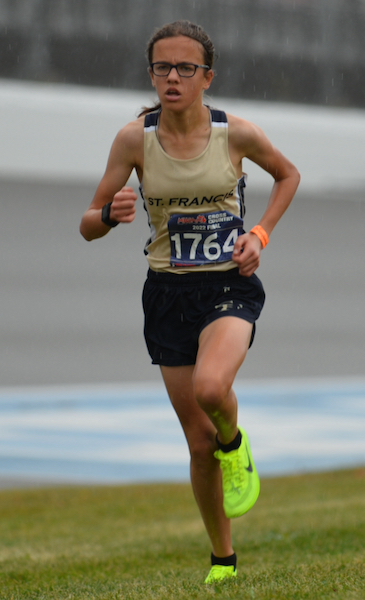
Petr's Kick Highlights EGR D2 Dominance
November 2, 2019
Second Half reports
BROOKLYN – As Anna Petr charged toward the finish line at Michigan International Speedway, trying to overtake the reigning champion, her mind began to think of all the people who helped her get to this position.
One special memory was that of her mother, Angela, who died from breast cancer Jan. 4, 2018.
“She was my coach until then,” said Petr, a senior at East Grand Rapids. “It was just really cool. I could just kind of feel her with me. I knew this was more than just about me. It was about my team and my family.”
Petr’s years of hard work came together in a duel with Lansing Catholic senior Jaden Theis in the MHSAA Lower Peninsula Division 2 championship Saturday. Petr ran down Theis to win in 17:59.6. Theis, who won last year and finished sixth at the Foot Locker National Cross Country Championships, was second in 18:02.7.
Petr moved to Michigan from North Carolina, where she was 38th in the state meet as a sophomore. In her first year at East Grand Rapids, she placed 20th in the Division 2 meet in 19:02.8, finishing behind 15 runners who returned this weekend.
“I wrote out all my goals at the beginning of the season and the steps I was going to take to get there,” Petr said. “It’s a little bit of a weird thing, but I found it really helps. I wrote like ‘top five.’ So, even that was a stretch. My coach looked at it and was like, ‘OK.’ I really wanted to make it happen.”
Petr first saw herself as a potential Finals champion eight days earlier when she beat Theis in the Regional at Uncle John’s Cider Mill in St. Johns. Petr posted a time of 17:52.5 that day to edge Theis by 3.4 seconds.
On Saturday, she didn’t believe she actually had a chance to win until about midway through the race.
 “I got to the front of the pack I was running with,” she said. “I saw one and two not that far off. I was like, ‘OK, I have to go win now.’”
“I got to the front of the pack I was running with,” she said. “I saw one and two not that far off. I was like, ‘OK, I have to go win now.’”
Even though she was the winner in 2018, Theis wasn’t disappointed in her finish this time. She has battled hip injuries since track & field season, greatly limiting her running. Taking that into account, she was content with her performance.
“I’ve run like five times in the past month, so not my best training ever,” Theis said. “But I’m really happy with the result from this, because I’ve been doing so little running.”
Petr led another dominant performance by East Grand Rapids, which repeated as Division 2 champion by scoring 36 points. Petoskey was second with 91.
The Pioneers put all five of their scoring runners in the top 13 in the team race. Hannah Bodine was seventh overall in 18:32.0, Katie Hessler was eighth in 18:32.9, Abigail Petr was 14th in 18:52.0 and Margaret Coney was 38th in 19:19.6.
“It’s such a cool experience to have my best friends racing and training with me all the time,” Anna Petr said. “It’s truly unique, so I’m very thankful for it.”
PHOTOS: (Top) East Grand Rapids’ Anna Petr (1351) pulls away from Lansing Catholic’s Jaden Theis (2052) and Plainwell’s Makenna Veen during the final stretch at MIS. (Middle) The Pioneers’ Katie Hessler (1349) and Hannah Bodine pace each other to top-10 finishes. (Photos by Matt Yacoub/RunMichigan.com.)

Jazwinski Brings Hart Individual Title as St. Francis Moves to Front of Team Pack
November 5, 2022
BROOKLYN – Cross country races can be won between the ears before runners ever step foot onto the course.
Attitudes were tested as rain began to descend on Michigan International Speedway and the wind picked up just before the start of the MHSAA Lower Peninsula Division 3 girls race late Saturday morning.
Hart sophomore Jessica Jazwinski was loving life as she prepared to race.
“As a distance runner, I really try to love the wind,” she said. “Distance running and cross country is just a tough sport. The wind just adds to it — and the rain, too. It’s super fun.
“I was just thinking these conditions are just gonna feed my great race. This is real cross country. Yeah!”
Jazwinski overcame the elements to run the fifth-fastest Division 3 time ever, winning with a time of 17:36.70. She has two of the top-five times in Division 3 Finals history, having run 17:31.4 to place third last year.
“Today my race plan was just to go out hard and try to hold on to my pace,” she said. “I feel like I tried to race a lot like Steve Prefontaine, just go out and hold on.”
 Lansing Catholic senior Hannah Pricco was second in 18:17.59, Onsted sophomore Emmry Ross was third in 18:20.96 and Hart junior Alyson Ens was fourth in 18:28.52.
Lansing Catholic senior Hannah Pricco was second in 18:17.59, Onsted sophomore Emmry Ross was third in 18:20.96 and Hart junior Alyson Ens was fourth in 18:28.52.
“I love having great teammates to work with and encourage each other,” Jazwinski said. “We really try to encourage each other so much throughout the races. Throughout this year, some races she’s been a minute behind me, some races she’s been five seconds. I don’t want her to ever beat me, so that pushes me so much. I know she’s trying to race me and get up there with me.”
The only downer for Hart was having its string of Division 3 championships end at five with a fourth-place finish. Hart had two runners in the top four, but its No. 3 runner was 68th.
“I would totally trade my individual title for a team title,” Jazwinski said.
Traverse City St. Francis emerged from a close battle to win its first title since 2016 with 134 points. Pewamo-Westphalia was second with 142 and Lansing Catholic third with 165.
Sophomore Betsy Skendzel led St. Francis, placing seventh in 18:48.33. Completing the team score were senior Sophia Rhein in 26th (19:43.27), sophomore Grace Slocum in 33rd (20:07.95), junior Rylee Duffing in 60th (20:44.82) and junior Margot Hagerty in 63rd (20:45.78).
Lansing Catholic had three place in the top 10, but didn’t get another finisher until 103rd.
PHOTOS (Top) Hart’s Jessica Jazwinski pushes toward the finish during Saturday’s LPD3 Final. (Middle) Traverse City St. Francis’ Betsy Skendzel leads the way for the eventual team champion. (Click for more from Dave McCauley/RunMichigan.com.)

